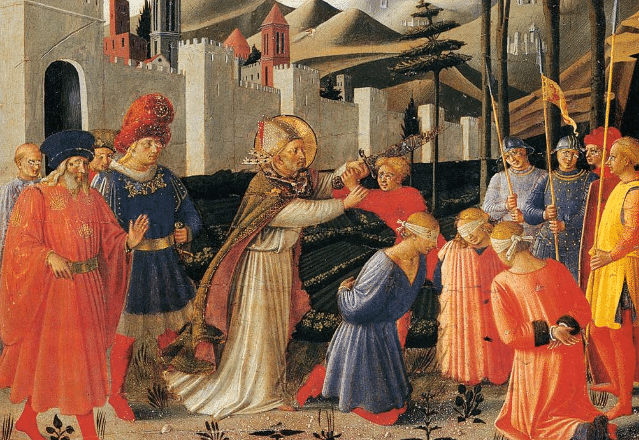Adam English and Charissa, his wife, want their daughter, Cassidy, now 10, to know the truth behind Santa. Did he bear any resemblance to the rosy-cheeked grandpa invented by Coca-Cola in the 1920s? Could there be fact behind that fiction? As a theology professor at Campbell University in North Carolina, Dr. English was well positioned to find out. Academically, he has long been “interested in the early Christian faith and the way that the early Church lived,” he says. He has also co-led month-long study-abroad programs to Italy, where the bones of Nicholas (at least, most of them) now rest in Bari, Italy, on the Adriatic Sea.
That’s how it started. “Everything I had read in preparation for visiting Bari, in preparation for seeing the documents there [at the Centro Studi Nicolaiani] led me to believe that St. Nicholas probably did not exist, at least as we thought of him,” says English. “Then I looked at the documents themselves and saw all the evidence. I’m convinced he did exist and did many of the things we have traditionally associated with him.
“For too long, we’ve felt that you can either have a Christian celebration or you can have Santa Claus,” says English, author of The Saint Who Would Be Santa Claus: The True Life and Trials of Nicholas of Myra.
“I’m not against Santa or gift-giving at all, but the tradition can be expanded, not only in the sense of being charitable, but also in the spirit of Saint Nicholas, reclaiming him as the inspiration behind gift-giving beyond the family at this time of year.”
Not-So-Secret Santa
What do people believe about jolly old Saint Nick? Those adjectives—jolly and old—may say it all, at least here in the United States, where red-suited Santa reigns over the month of December. Clement C. Moore’s playful poem, first called “A Visit from Saint Nicholas,” has been given the weight of biography for many children—and not a few adults.
According to that rhyming narrative, Saint Nicholas drives a toy-filled sleigh powered by reindeer through the air to the home of each and every child on Christmas Eve. The white-bearded elf is rather large in elfin terms, dresses in fur, enters and exits through chimneys, and smokes a pipe. While he’s welcomed by one and all, only this fictional fellow’s basic good nature would qualify him for the calendar of saints.
Moore, a Protestant seminary professor, wrote the fanciful verse for his children—and was actually embarrassed by its wide popularity. He might be even more embarrassed by the way his verse overshadowed the story of a historical saint. The truth, while ancient and elusive, offers more inspiration than the poet’s fiction.
What Could Be New about a Third-Century Saint?
Professor English set out to discover whether Nicholas had ever existed. If he was real, how had he morphed into a magical elf? He offers three major conclusions about a saint that he found even more impressive than the red-suited star of Christmas.
1) Saint Nicholas was real, asserts English. His book contrasts with the conclusions of three notable scholars: Gustav Anrich, translator of all the early Greek texts related to Nicholas; Charles W. Jones, Berkeley professor of antiquity; and Peter Brown, an authority on early Christian saints.
These scholars had led Dr. English to fear that Saint Nicholas (a.k.a. Santa) was a piece of pious fiction. Still, “as a lover of all things Christmas,” he wanted to draw his own conclusions.
The extensive library in Bari, Italy, managed by Dominican friar Gerardo Cioffari, provided compelling evidence of the saint’s historicity. Bari, where most of the saint’s bones are now interred, is a center of devotion to the saint of Christmas. For English, theBari library documents were a “eureka discovery.”
2) At least two holy men named Nicholas lived in ancient times, and their stories have often been confused and combined.
Saint Nicholas of Myra, who died in 335, and Saint Nicholas of Sion, who died in 564, are not the same fellow, says English. “Typically, that distinction is not maintained,” he says. English considers his efforts to untangle them a personal victory of scholarship. In the 10th century, the stories of these two saints were merged, perhaps inadvertently, by Symeon Metaphrastes, Dr. English speculates. “I restore them as distinct individuals.”
He grants that “anyone could look at the [Bari] documents, but they’re fairly muddled at first glance, so it does take some investigation.” Symeon’s purpose was to inspire his readers, and he may well have combined the two Saints Nicholas just to double the dose of mayhem and miracles that both lives offer.
The latter Nicholas (of Sion) was also a bishop, probably named after the earlier saint to whom there was already widespread veneration. Born in the same part of the world, both died in the month of December and both stories feature tales of miracles at sea, but the two saints lived nearly 200 years apart.
English believes that we can probably dismiss stories of boy bishops, rescue from homicidal butchers, or raising young boys from the dead, all of which have been told about Saint Nicholas of Myra. In his book, English writes that plays featuring Nicholas were the first non-liturgical, non-biblical plays of the Middle Ages. Their popularity demonstrates that of the saint himself, but such dramas often emphasized sensational, fantastic stories attached to the saint—exaggerated for entertainment value.
3) Saint Nicholas of Myra has more to offer than his example of gift-giving. While Saint Nicholas’ connection to Christmas offers ample cause for imitation and celebration, a fuller picture offers reasons to honor his example throughout the year, says English. Nicholas traveled to Constantinople to plead for tax relief on behalf of the citizens of Myra. The professor finds this interesting because early saints are often reported to be disdainful of money, even unaware of economics. He describes the bishop as “someone very much involved in the public good, very much involved in society.”
English points out that the earliest credible story connected to Saint Nicholas, remembered in stained glass and frescoes as well as historical documents, is not of generosity but of justice. Michael the Archimandrite, the first biographer of Nicholas, records the tale. The elderly bishop of Myra intervened at the last moment to halt the execution of three individuals condemned by an unjust judge.
“It’s a fascinating story,” says English, “because in it we see Nicholas acting not simply as a Christian pastor or a religious leader, but as a social activist. This is someone of high standing in the city, high enough to be able to intervene.” This story includes a “number of specific places, proper names rooted in history, and other clues that verify this as a legitimate historical account,” English says, contending that this story alone verifies the saint’s historicity, as well as his courage and his influence.
Debunking Myths
Adam English has tried to remove what he calls “barnacles and add-ons” to get to the essence of Saint Nicholas. He would contend that the pious excesses of early biographers aren’t needed to legitimize the sanctity of a saint whose name adorns more churches around the world than anyone else other than Mary, mother of Jesus Christ.
The feast of Saint Nicholas is celebrated on December 6. While exact dates are hard to come by, it’s interesting that this date was a festival in honor of the goddess Artemis (mythically born on the sixth day).
English reports that an important shrine to Artemis was located in Myra. Bishop Nicholas had returned from the Council of Nicaea (which crafted the basis of the Creed we recite on Sundays) with evangelistic zeal to end the cults of pagan gods and goddesses within his pastoral purview. His earliest biographer, Michael, describes him actually physically tearing down the temple in Myra. Since he was over 70 at the time, who knows?
Yet, it is this powerful and effective opposition to the pagan celebrations and the implied trust in powers other than the One True God that probably positions his feast on December 6. Today, it is Nicholas, not Artemis, who is celebrated on this day, for, as English writes, it was his pastoral zeal that led the people of Myra from paganism to Christianity.
Why So Popular?
While we celebrate Nicholas on December 6, it isn’t his victory over Artemis that gains him his ascendancy in the calendar of the saints. Saint Nicholas is popular far beyond that. But why?
Adam English has thought a lot about this. He says, “This is someone to whom literally everybody can relate to some degree. Many saints are remembered for something miraculous, for some strange and bizarre behavior.
But, with Nicholas, it’s an ordinary man. He was living his life, working for justice, giving gifts, looking out for people. These are the kinds of things you and I can do. So I think he has that immediate appeal to people who are looking for examples in life, looking for models of Christian behavior.”
Celebrating the Saint
In this month of December, then, how might Christians best celebrate this saint, dressed as a bishop or disguised as Santa? Adam English and his family have widened their view of this season. He says, “When we give in the spirit of Saint Nicholas, it requires that we not only give to people whom we know and love, but to people whom we do not know and do not love. This was the real discovery for me in terms of my own Christmas celebrations.”
He recalls the most well-known story about St. Nicholas, part of the first biography by Michael. The story describes a father whose desperate straits tempt him to sell his unmarried daughters into prostitution for lack of a dowry. In the original story, English says, a very young Nicholas goes by the window at night to toss in a bag of gold. He repeats this three times.
“In later retellings of the story,” English recalls, “Nicholas finds the windows locked, so he has to drop the bag of gold down the chimney, where it lands in a stocking that’s hanging by the fireplace. So the chimney and the stocking are really from this story.” And Clement Moore seized on that tale to pen his line, “The stockings were hung by the chimney with care, in hopes that Saint Nicholas soon would be there.”
English says that people can honor the Nicholas tradition literally by having their children put out their shoes (or stockings) on the eve before December 6. Traditional treats that appear by morning usually include some gold coins and a candy cane to represent the bishop’s staff. (We might have to settle for quarters these days!)
But the larger view requires selfless giving throughout the days before Christmas, not merely token remembrances. Adam English, author, teacher, and parent, says, “I can give anonymously to people I don’t know. I can stand up for justice. I can do acts of public service, beyond the family. The whole family can wrap gifts to contribute to Toys for Tots or similar community charities. In some way, gift-giving has to go beyond our immediate family.”
Adam English began his multiyear quest wondering if there was indeed a real Saint. Nicholas. He wondered about his reality, just as little Virginia O’Hanlon had wondered about our modern-day Santa’s existence. And the answer given in the famous New York Sun editorial might well be said of Santa’s saintly counterpart, Saint Nicholas of Myra: “He exists as certainly as love and generosity and devotion exist. . . .Thank God! He lives, and he lives forever.”










5 thoughts on “Saint Nicholas: Fact or Fiction?”
Pingback: Saint Nicholas – Saint Gregory the Great Catholic Church
How can you listen to the article for the Saint of the Day. Recently one only needed to click on the words Listen to Saint of the Day. I no longer can find a choice to listen to the story of each day’s Saint.
We should keep hope and believe. Whether it be Saint Nicholas or aka Santa Claus , or not. In the month of December we should give onto others. Some that are in need we do not know , or our own family. Also acts of kindness love charitable donations & etc. , what you give comes back to you , but only if it’s from the heat don’t give it to get something back. I thought the story was quite touching about the gold being dropped down the chimney into the stocking. I’ve always heard as a child. Merry Christmas happy holidays to you all….
Santa at Ace Hardware fought off the candour of a 62-year-old man. After he asked to sit on St. Nick’s lap. “Only if you’re a good little boy” he replied”!
Pingback: CatholicSaints.Info » Blog Archive » Saint Nicholas of Myra